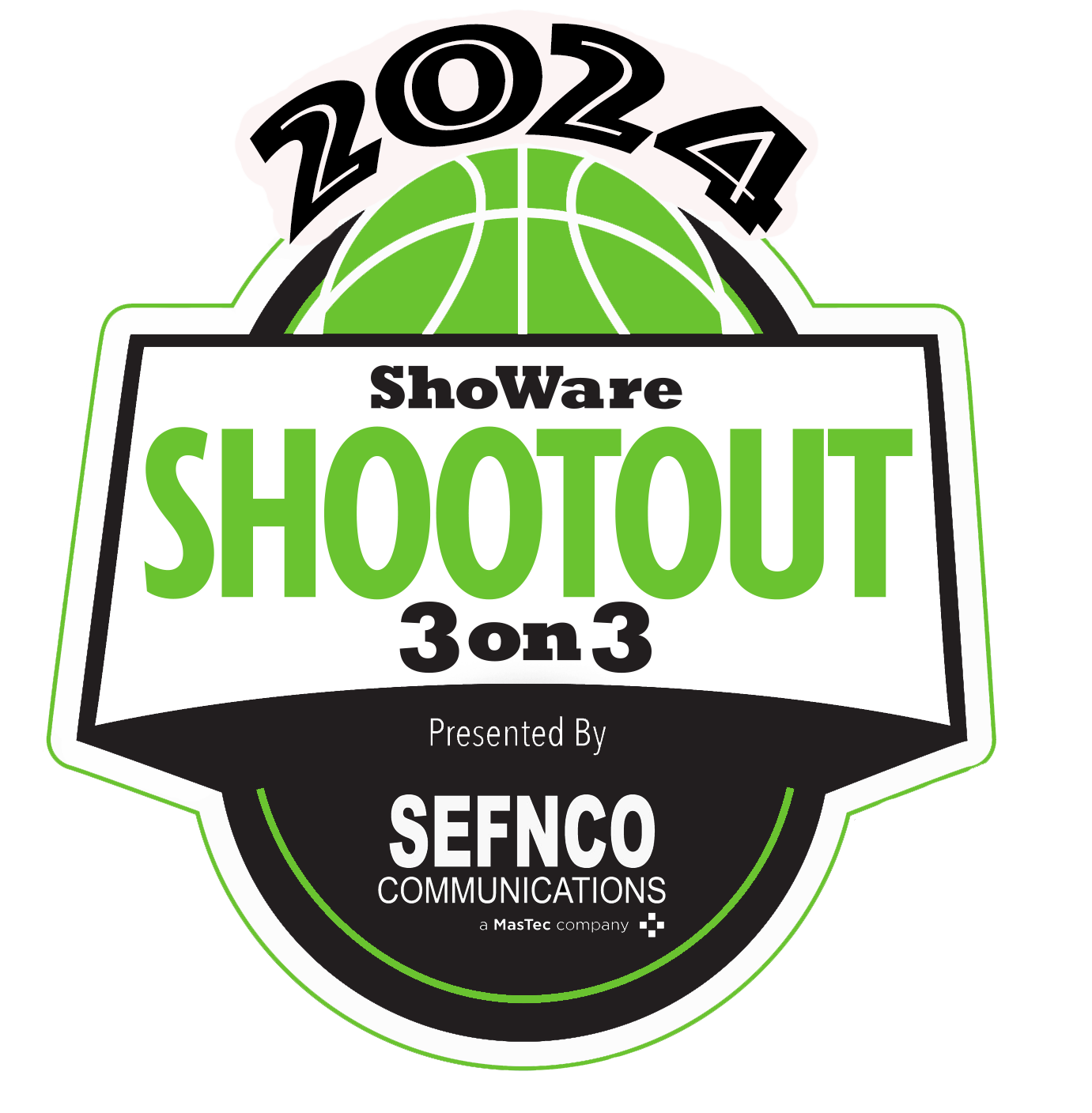Shootout Rules
SHOWARE SHOOTOUT SPORTSMANSHIP POLICY
Sportsmanship is both anticipated and expected. The team captain or designated parent, if applicable, is expected to aid in controlling teammates’ and team followers’ conduct and to represent his/her team as spokesperson in case of appeals to the court monitor. Poor sportsmanship could result in penalties against the team. Failure to comply, with acts such as fighting, taunting, intimidating or verbally attacking a tournament official, player or spectator may lead to removal of that player, team and/or spectator from the tournament. Any ejection from the entire tournament will result in a suspension from the next year’s ShoWare Shootout, at a minimum. Decisions made by tournament officials are final, and are not subject to review by video or other recordings, or other sources.
SHOWARE SHOOTOUT RULES AND REGULATIONS
Who Can Play
The tournament is open to players entering grades 3 through 12, as well as all adults.
Number of Players
Each team may consist of a maximum of 4 players and a minimum of 3 players. A team may have only 3 players on the court at any time. For all co-ed teams, a member of the opposite sex must be on the court at all times. All games must start with at least 3 players on each team. Any number of players (1, 2, or 3) may complete a game.
Authorized Equipment & Apparel
No player shall be allowed to wear a guard, cast, hard brace or other potentially dangerous equipment on his or her elbow, hand, wrist, finger, or forearm, including equipment made of hard leather, plastic, plaster or metal—even if the equipment is covered with soft padding. Soft braces, sleeves and wraps will be allowed unless they pose a danger to other players. As always, ShoWare Shootout personnel retains the right to disallow any equipment or apparel that it judges to be dangerous or inappropriate.
Eligibility Issues
All high school and college players are encouraged to check with their coaches and/or athletic directors about participating in the ShoWare Shootout and the potential effects on their eligibility. ShoWare Shootout and it’s staff is not responsible for determining a particular athlete’s eligibility under National Collegiate Athletic Association or applicable high school association rules.
Bracket Types
Teams will be divided into tournament brackets according to its players’ ages or immediate upcoming school grades, heights, playing experience, and competition level, in accordance with the information on each team entry form. Tournament officials reserve the right to verify a player’s entry form data. False information will be grounds for dismissal from the tournament.
Each player in all brackets 7th grade and above must possess photo identification upon sign-in. Failure to do so will result in ejection.
Basket Height
Baskets will be 8 feet high for teams whose players are entering grades 3 and 4; the height will be 10 feet high for all other brackets.
Basketball Size
The intermediate size ball will be used for all female games and any male or co-ed games consisting of players entering grades 3 through 6. The full size ball will be used for all other games.
Free Throw Shooting Distance
The distance for free-throws will be 10 feet for brackets consisting of teams whose players are entering grades 3 and 4 and who are playing on a 8 foot basket; the distance will be 15 feet for all other brackets.
Two-Point Shooting Distance
The distance for two-point shooting is 16 feet for brackets consisting of teams whose players are entering grades 3 through 6; the distance will be 19 feet for all other brackets.
Stealing the Ball
Players in all age categories may steal the ball when it is being passed. Brackets consisting of teams whose players are entering grades 3 and 4 will have a no-steal rule when players are either dribbling or holding the ball. Stealing in those situations will be allowed in all other brackets.
Fouls
In most brackets, the participating players will call their own fouls. More specifically, the player that was fouled will call the foul. All called fouls shall result in one free throw shot, except on successful field goals, in which case the basket counts and no free throw shot is awarded. During a free throw, opposing team players may not intentionally disrupt the shooter’s unhindered throw. A change of possession will result regardless of whether the free throw shot is made or missed. After a foul shot, the ball will be placed into play from the back-court line. Incidental contact between opponents shall not result in a called foul unless such contact results in a meaningful disadvantage. Court monitors will referee all games in brackets consisting of teams whose players are entering grades 3 through 9 as well as all games in the adult Elite Division.
Technical Fouls
A technical foul will be called for unsportsmanlike acts such as taunting, baiting, or trash talk. Taunting and baiting can involve derogatory remarks or gestures that incite or insult a player. Trash talk involves a deeply personal, verbal attack directed toward any person involved in the event. In extreme cases, the player may also be suspended from play and a coach or fan removed from the court for the remainder of that game or for the rest of the tournament. A player who aggressively comes into contact with or assaults a court monitor, court marshal, or other tournament official shall be automatically ejected from the game and for the remainder of the current tournament. Additional suspension for such acts will be determined by the ShoWare Shootout management on a case by case basis. The court monitor may also assess a technical foul if the monitor determines that the team is stalling in the interest of preserving a winning margin. A technical foul results in one point for the offended team and possession of the ball.
Intentional Fouls
An intentional foul is a foul designed to neutralize an opponent’s obvious advantageous position. It is a foul which, based on the court monitor’s observation of the act, is not a legitimate attempt to directly play the ball. A foul shall also be ruled intentional, based on the monitor’s observation of the act, if while attempting to play the ball, a player causes excessive contact. An intentional foul results in one point for the offended team and possession of the ball.
Flagrant Fouls
A flagrant foul may be of a violent or aggressive nature, or an act which displays unacceptable conduct. It may or may not be intentional. It may involve violent or aggressive contact such as striking, kicking, kneeing, moving under an opponent who is in the air, and crouching or hipping in a manner which could cause severe injury to the opponent. It may also involve dead ball contact or dialogue which is extreme or persistent, aggressive, or abusive. A flagrant foul results in one point for the offended team and possession of the ball. The player committing the foul will be suspended from play for the remainder of that game and possibly for the rest of the tournament.
Technical, intentional, and flagrant fouls cannot be called by a player. A court monitor or court marshal will make this call. Their decision is final.
Stalling
Stalling is prohibited. Stalling is a style of play in which a team does not actively attempt to advance the basketball toward the basket and shoot the ball at the basket. It is a method used in an attempt to run out the game clock to preserve a win. Stalling is considered an unsportsmanlike act and will result in a technical foul against the offending team.
Which Team Receives the Ball First?
A coin toss prior to each game will determine which team gets the ball out-of-bounds first.
Keeping Score
All made baskets from inside the two-point arc count for one point and made baskets from outside the two-point arc count for two points. The first team to 20 points is the winner.
Length of Game – All Divisions (excluding the elite divisions)
If a score of 20 is achieved within 25 minutes
The target score for all games is 20 points, meaning the first team to reach 20 points within 25 minutes of play is declared the winner. The team that reaches 20 points does not need to have a winning margin of 2 points or greater. The 25 minute clock is stopped during team time-outs and if the court monitor stops play for a player injury or other unusual circumstance. If neither team has reached a score of 20 points, the court monitor shall stop the game after 25 minutes of play.
If a score of 20 is not achieved within 25 minutes
If at this point of interruption a team has a lead of 2 or more points, that team is declared the winner. If neither team has at least a 2 point advantage, the overtime rule will be activated. In overtime, the first team to score a total of 2 points more than the leading team’s score at the beginning of the overtime session, or reach 20 points, will be declared the winner. A coin toss will determine who gets the ball out of bounds first in overtime. Use these examples as a guideline:
SCORES AT BEGINNING OF THE OVERTIME SESSION
Score of 19 to 18: the first team to 20 wins (no game goes beyond 20 points)
Score of 16 to 16: the first team to 18 wins
Score of 8 to 7: the first team to 10 wins
Score of 14 to 12: no overtime is needed since the leading team has at least a 2 point lead
Checked Ball
The ball must be “checked” by an opposing player before it is put into play. The ball must then be passed to begin play. In games consisting of players entering grades 3 and 4 played on an 8-foot basket, the initial pass after the “check-in” may not be contested. However, the player receiving this initial pass must be behind the free-throw line extended.
Change of Possession
The ball will change possession after scored baskets and all free-throw attempts with the exception of Technical, Intentional or Flagrant fouls. There will be no “make it, take it” rule.
Taking It Back
The ball will be “taken back” on each change of possession, regardless of whether or not a shot was attempted. Failure to “take it back” results in loss of possession and any points just scored. “Taking it back” means bringing your whole body and the ball behind the dashed “take-back” line, not the sidelines or 2 point arc.
Ball Out-of-Bounds
A ball out-of-bounds will be taken out from the back-court line.
Boundaries
The basket structure, padding, and structural supports will be played as out-of-bounds. The actual backboard, including its face, top, bottom and sides, shall be considered in-bounds.
Jump Ball
In a jump ball situation, the ball will first go to the team which lost the opening coin toss, with alternating possessions thereafter.
Dunking
Dunking is not allowed at any time, including during warm-ups. Dunking will be construed as an unsportsmanlike act and will result in a Technical foul.
Substitutions
Substitutions may only be made during a time-out or a “dead ball” situation.
Time-Out
Each team is allowed a single one minute time-out per game. The clock will stop running during a time-out.
Wheelchair Participants
Players in the wheelchair division should be aware that a liberal four second in the key rule will be enforced. All wheelchair players not currently active in any game must stay positioned behind the back-court line and not inside the curbing along the sides of the court. Chair measurements are expected to be in accordance with established wheelchair rules.
Player Injury
A court monitor has the discretion to suspend play for the protection of an injured player. If a player is bleeding or has an open wound, that player will be directed to leave the game and properly bandage the wound. A player with any bloodstained clothing or bandage must remove the stained or saturated material prior to re-entering the game. If it is believed that a player has lost consciousness during a game, or is severely injured, the ShoWare Shootout may require a written note from a medical doctor who has examined the player subsequent to the game injury and specifically authorizes that player to continue participation in the tournament.
Game Times
All printed schedules are effective through only the first game for all teams. Following the tournament’s first game, each team is required to check the Master Scoreboards for all official schedules, times, courts, revisions, and general game information. Teams must be ready to begin play at their scheduled start time. Teams not at their court for their scheduled game are given a 5 minute grace period before a forfeit is enforced. Teams are encouraged to remain in contact with their court to observe the effects of scheduling changes that could occur mainly due to inclement weather or other unexpected delays. Inclement weather and non-playable situations may result in the modification or cancellation of the event. Under these unlikely circumstances team entry fees will not be refunded.
The Fine Print
Designated tournament officials shall have the power to make decisions on any points not specifically covered in the Rules and Regulations and shall also have the complete authorization to interpret the intent and purpose of these Rules and Regulations. ShoWare Shootout officials also reserve the right to disqualify any player and/or team for infractions of tournament policies, including the following:
Use of Illegal Players
The players listed on the team entry form as accepted by the ShoWare Shootout are the only ones eligible for play on that team. Player changes submitted on authorized Player Change Forms, and accepted by tournament officials, must be completed and approved by 8:00 a.m. on Saturday, August 7, 2010. Under no circumstances will roster substitutions be allowed after the tournament begins. Before the beginning of each game, every player will sign a Release and Waiver and Sportsmanship Pledge. Any team using a player not properly registered will be disqualified from the tournament.
False Information
Information provided on a team entry form or accepted Player Change Form is the basis for bracket scheduling and is expected to be both accurate and complete. Players listing inaccurate information on these forms may be disqualified from the tournament.
Technical fouls
Any swear word heard by the officials will be called a technical foul on the offending player. The technical foul results in loss of ball and one point to the other team. A total of three technical fouls and the player is ejected from the game. But the player can play in the next game.



